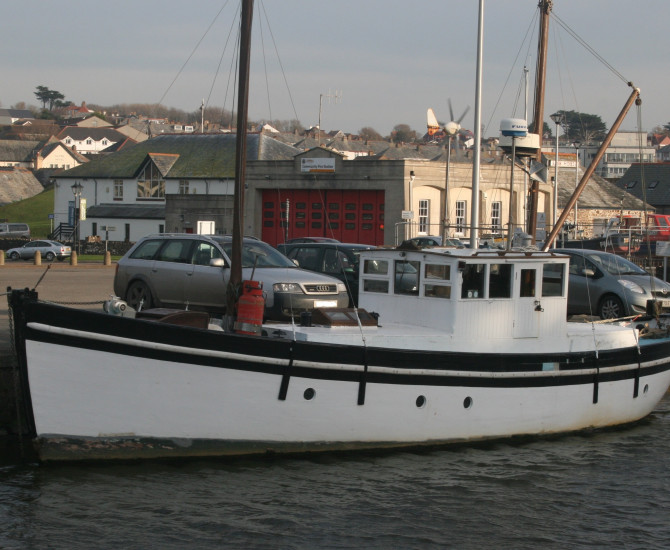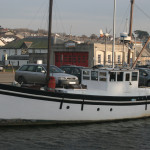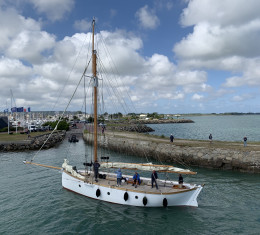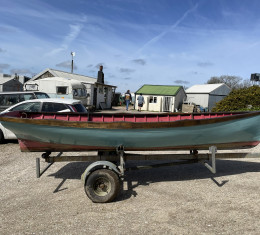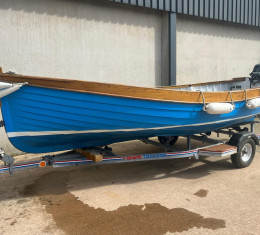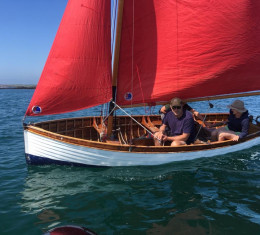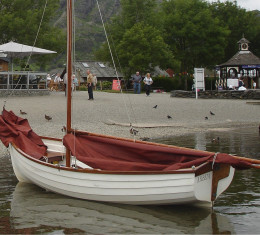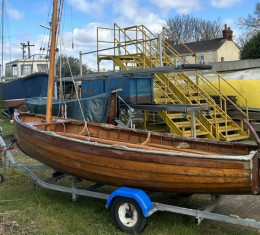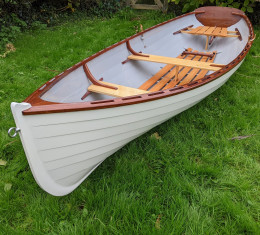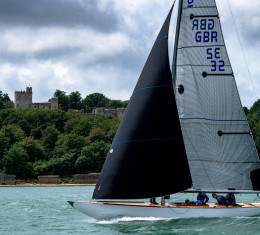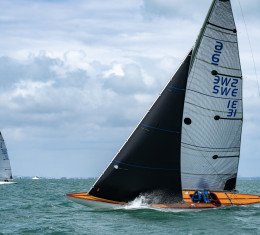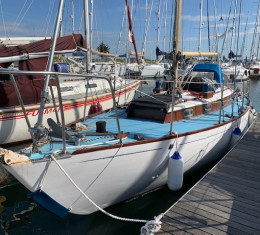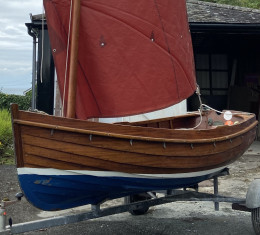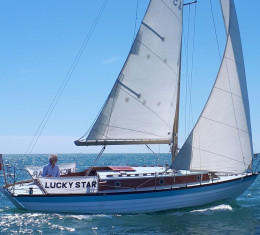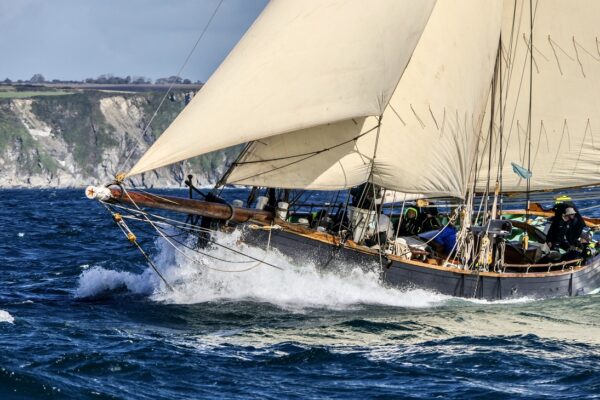Motor yachts
Full specification
Wooden ships comments on this Scottish Trawler yacht
This unique vessel was built immediately pre-war as a yacht on the lines of a Scottish fishing boat.
The story is that her owner, a retired Naval Commander appears to have anticipated war and the need for boats. She is reputed to have carried secret agents from Scotland across to German –occupied Norway, there is a “secret” compartment where a man could have lain hidden and a fragment of a map of Norway is amongst the papers.
In 1947 the vessel was sold to the Bibby family for £3500 and remained with them usually based in Dartmouth until sold in 1963 to a Mr Buxton who berthed her in Glasson Dock, Lancashire where according to the next owner she suffered some neglect.
In 1986/7 she was sold to a Mr and Mrs Miles Irving and moved to S Wales where she was based at Rudders Boatyard, wintering at Neyland Marina and later at Rhoose Ferry, wintering in Pembroke Dock.
The Irving’s farm-house burnt down in 1994 and with it documents relating to the history of the vessel but in a letter Mrs Irving relates some of that history.
When Miles Irving fell ill she was sold in 2005 to a Cornishman. For a brief period she had live-aboard owners before coming into present ownership in 2007.
Inspected in November 2013 and found in tidy and ostensibly sea-worthy condition and very little changed from the original which is a great bonus. The lay-out with an owner’s 2-berth cabin aft, a 2-berth cabin forward for the crew and forward galley and heads and a very pleasant saloon cabin has remained unchanged with all the original joinery. One of the bunks even has the original Simpson Lawrence bunk spring frame.
Although evidently a fishing boat design from a fishing boat yard the construction indicates her yacht origins. The use of pitch-pine and noble metal fastenings and the simple but original joinery are all very special features of this vessel.
Not only is this a fascinating piece of history, she is a very usable vessel of a rare and practical size and ostensibly ready to go to sea.
Formerly Part 1 registered, now lapsed.
Built by Weatherheads of Cockenzie on the Firth of Forth near Edinburgh in 1938 to a design very typical of the fishing boats this yard was building.
The design features the usual Scottish fishing boat rather pointed canoe stern, a long straight keel and straight, raked stem. Built a yacht she might be a fraction leaner in the beam than her working boat sisters.
Planked in larch, carvel laid, caulked and payed in the traditional way.
A contemporary article notes the planking to be larch and pitch-pine and the fastenings as yellow metal and plugged which is very yachty.
Oak frames in pairs of sawn futtocks 2 x 3” moulded, 3” sided at 18” centres.
Oak back-bone.
Pair of fixed port holes each side in the saloon, port hole to galley and head and each-ride to the aft cabin.
Internal iron ballast. The ballast seen was in the form of a number of iron pigs of approx 100cwt each + a large number of smaller iron items approx cricket ball size but obviously cast for a particular use, possibly associated with a furnace. Total ballast estimated at 2 ½ tons.
This ballast was reported to have been removed, cleaned and painted by the previous owner and certainly appeared very clean.
Deck. The deck is straight laid pitch-pine (according to contemporary article), caulked and payed and fastened to oak beams with brass screws.(see contemporary article)
Side deck tie-rods maintain deck stability.
Coach-roof deck beams over the saloon cabin are varnished and show a very sweet moulding not usually found in fishing boats.
It is suspected that the deck under the deck paint is the same timber as the cabin joinery which appears to be pitch-pine or a similar yellow pine with a fine grain and colour.
A low bulwark all round the deck is carried on oak stanchion posts which appear to be one of the pairs of frame futtocks extended through the cover-boards in the Scottish manner.
Again in the Scottish manner the cover-boards are created by individual blocks of wood between the stanchion posts resting on wooden cleats spiked to the sides of the frames with the outermost deck plank set hard up against the inner face of the stanchion posts thus making stanchion post replacement in case of damage much simpler and cheaper.
Cavil bars on the bulwarks to take mooring lines.
Twin chain rollers on the stemhead.
Modern 12v windlass on the fore deck.
The wheel-house has a door on the port side set high over the coaming step. This little wheel-house, 8’ long, 6’ wide and recessed 2’below deck level sits well in the boat with 6’ head-room under the beams yet still affording excellent visibility.
An unusual and original Kelvin spoked wheel works on wire cables to a huge circular quadrant on the rudder stock in the lazarette
Helmsman’s seat.
Drop down flap seat over the aft cabin companionway.
Chart desk in after stbd corner
A forward coach-roof over the saloon cabin and an after coach-roof over the aft cabin both have pitch-pine coamings and T&G pine decking sheathed more recently in grp and painted.
Traditional varnished sky-light and two mush-room vents on the fwd coach-roof.
A traditional varnished teak entrance hatch on the fore deck gives independent access for the paid hand in the fore peak cabin.
Rig. 2 masts.
A taller after mast stepped in a galvanised tabernacle on the after coach-roof fitted with bronze sail track and carries a boom with topping lift sheeted to the after peak. A sail is carried for this mast.
Fore mast stepped in a tabernacle on the fore deck just fwd of the coach-roof.
Stowage facility for twin gas bottles against this mast.
Galvanised rigging wire to heavy external chain plates with galvanised rigging screws.
This rig bears a distinct resemblance to the rig shown in original photos published in the magazine article except that the mizzen mast was originally keel stepped and the partners are still seen in the aft coach-roof deckhead. The fwd mast appears to have been originally stepped on deck as at present and designed to be lowered aft as were the rigs of the early Scottish East Coast sailing fishing boats.
The masts are oiled, tapered at the head with the top 4’ + trucks painted white and may well be the originals.
Engines.
Dedicated engine room under the wheel-house floor. Entrance by low-level doorway stbd side in the saloon after bulkhead. 4’ head-room in the engine room. Bench seat along the stbd side with agreeable floor space.
Matching doorway on the port side gives access to the wing engine without climbing over the main engine.
The vessel was originally fitted with a Kelvin Ricardo 30hp petrol paraffin main engine and a 30hp Kelvin Ricardo wing engine. The petrol tank was placed on the wheel-house roof.
Russell Newbery DM4 4-cyl diesel engine solidly mounted on the centre-line on substantial engine beds with centre-line shaft and conventional stuffing box bearing to a 3-blade prop.
Fresh water cooled with heat exchanger. Interesting pipe-work and valves appears to permit the cooling water to be drawn from either of 2 sea-cocks or the bilge.
12v engine start.
A spare engine is included with the boat including blocks, fuel pump, crankshaft, one spare head, valves and valve seats etc
Self Changing Gears of Coventry ahead and astern gear-box with 2-lever controls at the helm.
6knts at 850rpm cruising revs. 1200rpm max.
Wing engine. Perkins 3-cyl diesel (as used in MF tractors) with Borg Warner hydraulic gear-box mounted to port with conventional shaft drive.
Fresh water cooled with heat exchanger.
The wing engine gives 4knts
A good quantity of spares for both engines are carried on board. In addition an active Russell Newbery Owners Assoc provides a selection of spares.
Tanks.
Fuel. 75 galls diesel carried in twin cylindrical tanks, one each side of the engine room.
Modern filters and water traps.
Water. Home made in previous ownership grp tanks under each of the fwd cabin berths containing estimated 15 galls each with 12v pressure pump to the galley sink and heads basin.
Electrics.
1 large 12v battery located on the ER floor by the door.
Dedicated engine start battery on the wing engine.
Original electrical meters and switch-board in the engine room.
Accommodation.
4 berths + 2 settee berths in the saloon cabin.
The vessel is divided into 5 compartments – an aft cabin, the wheel-house with engine room below, the saloon cabin, the heads and galley area and a fore cabin.
Aft cabin with generous port and stbd berths. Port hole in the hull each side above each berth.
The port berth is still fitted with the original sprung frame under the mattress.
Varnished pitch-pine joinery with drawers and lockers.
Port side steps up to the wheel-house.
Centreline steps from the wheel-house down forward to the saloon cabin. Port and stbd Chesterfield style settees, stowage under the behind.
Sideboards at the fwd ends with glass door lockers above
Mahogany drop-leaf table.
Painted sole boards. Painted T&G bulkheads. Painted coamings and deck-heads with varnished oak coach-roof beams
Centre-line fwd passageway runs up to the fore cabin.
Galley to stbd with recent smart 2-burner grill and oven gas cooker. Gas bottle on deck alongside the fore mast. Stainless steel sink and drainer. Pressurised water supply, 12v pump with switch by the sink. Sink drains overboard.
Heads compartment to port with original SL sea toilet and porcelain hand-basin.
Port holes each side to galley and heads.
V-berths in the fore cabin with the feet almost up against the stem post.
Home-made grp fresh water tanks under the berths
Fore hatch over.
Original joinery with drawers and lockers under the berths
An old 12v fridge is temporarily sited on the port berth – reported in working order.
Head-room.
Wheel-house 73” under the beams
Aft cabin 69” “ “
Saloon cabin 75” “ “
Galley and Heads 68” “ “
Fore cabin 83” under the fore hatch
Bunk Length
Aft cabin 83” x 30”
Saloon cabin 83” x 24”
Fore cabin 79” x 24”
Equipment.
Admiralty “Life-boat” design steering compass under a polished copper hood with original lamp in box on the side.
Autohelm Cetrek Pilot 730 auto-pilot
Sailor RT2048 VHF radio
Sailor RT 144B VHF Radio
Swiftech VHF radio
Recent Furuno radar
Old Kelvin Hughes Kingfisher radar with recon scanner.
Lowrance Global chart plotter
Furuno GP31 GPS Navigator
Vision GPS chart plotter
Trailing log
Clock and barometer
Original spot-light, boxed.
Legs.
Modern 12v windlass with chain and anchor
Fenders and mooring warps.
Large quantity of spares
Disclaimer:
These particulars have been prepared in good faith from information provided by the Vendors and are intended as a guide, Wooden Ships cannot guarantee or warrant the accuracy of this information nor warrant the condition of the vessel. The Purchaser should instruct his agent or surveyor to validate all details as necessary and satisfy himself with the condition of the vessel and its equipment.
Wooden Ships classic yachts brokers have an extensive database of boats for sale. With a wide range of sailboats, classic yachts, motor yachts and small classic boats, Wooden Ships has one of the largest selections of traditional wooden boats and yachts for sale in the UK.
Disclaimer:
These particulars have been prepared in good faith from information provided by the Vendors and are intended as a guide, Wooden Ships cannot guarantee or warrant the accuracy of this information nor warrant the condition of the vessel. The Purchaser should instruct his agent or surveyor to validate all details as necessary and satisfy himself with the condition of the vessel and its equipment.

